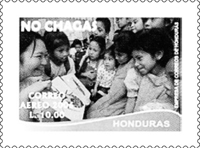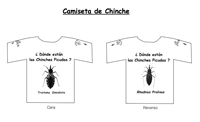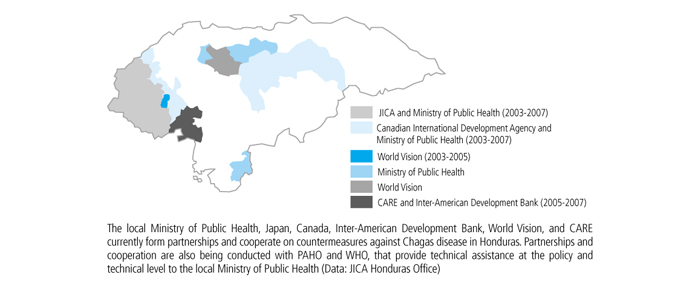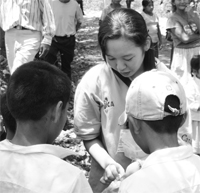Japan's Official Development Assistance White Paper 2007
Column 9 A Battle against Chagas disease — The Silent Infection
Have you ever heard of an infectious disease called Chagas disease? It is a parasitic disease transmitted via an insect commonly called "kissing bug". In some instances people that go without treatment may die from this disease 10 to 20 years later for reasons such as heart disease. Although the disease is not widely known in Japan, some point out that Chagas disease is the second most serious tropical disease in Latin America, after malaria. Approximately 10 million people in Latin America are currently infected by the disease, and around 200,000 individuals contract the disease annually. It is said that a great number of residents of Latin American countries face the risk of being infected.

A stamp created as an expression of gratitude for assistance and friendship from Honduras to Japan. Yamauchi is on the left

T-shirt with 'Where is the kissing bug?' written in Spanish and actual sized assassin bugs printed on the arms
The greatest issue surrounding Chagas disease is that there is no appropriate treatment method once the disease progresses. Moreover, the disease often advances to the chronic phase without displaying any noticeable symptoms, and many people lose their lives. It is also referred to as a "disease of poverty" as poor people that reside in homes with thatched roofs and clay walls where kissing bugs thrive are especially susceptible to the disease.
In response to this serious illness, it was decided at the 51st World Health Assembly held in 1998 that the "transmission of Chagas disease will be interrupted by 2010." Various efforts are currently underway in light of this decision within the Pan American Health Organization and Central American countries. Japan has also dispatched experts through JICA, as well as Japan Overseas Cooperation Volunteers, as part of efforts to address Chagas disease.* As a result of working together with the local Ministry of Public Health, between 2000 and 2007, persistent efforts to disperse insecticides through houses in order to exterminate the vector led to extermination in 472,000 houses in Guatemala, El Salvador, and Honduras. This helped to avoid the risk of infection for more than 2.3 million people.
In addition to extermination activities, Japan also focuses on educational activities for residents conducted by experts and Japan Overseas Cooperation Volunteers. Shino Yamauchi, who was dispatched to Honduras as a Japan Overseas Cooperation Volunteer from 2004 to 2006, is one of the people that have contributed to these activities. Believing that it was necessary for residents to understand more about Chagas disease itself in addition to just spreading insecticide, Yamauchi visited backcountry villages during the intervals between projects and provided explanations on Chagas disease.
Yamauchi created a situation where residents would independently become interested in the disease by walking around the villages she visited wearing a t-shirt that she had personally designed and proactively making conversation with local residents. Yamauchi looks back on her time, saying, "After showing an enlarged picture of a kissing bug, I was flummoxed after actually being asked, 'Are there bugs this big? I've never seen one.' Then, when making the t-shirt, I wrote 'Where is the kissing bug?' on the front and printed actual sized kissing bugs on the arms. Everyone took interest in the shirt and came to talk to me, making it a prime opportunity to discuss Chagas disease. The health volunteers and other Japan Overseas Cooperation Volunteers that I worked with still wear this t-shirt up today, using it when the provide explanations on Chagas disease."
Yamauchi says that it is important to conduct activities that allow residents to independently face Chagas disease even after the completion of the project. She asserts that, "We cannot stay onsite forever to provide assistance. Therefore, it is important that we assist as many people as we can in understanding the disease and create an environment in which residents can work to eradicate it on their own even after we are gone."
These accomplishments are highly praised in project countries and other recipient countries. The depth of praise in Honduras can be ascertained from the fact that an image of Yamauchi working has become the design for a stamp. Yamauchi has now returned to Japan. Nevertheless, the next volunteers are currently conducting proactive activities onsite, following in her footsteps. Their activities continue up until today, advancing toward the day when Chagas disease disappears from Central America.


Yamauchi explaining to children about test kits for Chagas disease (Photo: Shino Yamauchi)


 Next Page
Next Page